高考英语二轮复习课件:时态(共22张PPT)
文档属性
| 名称 | 高考英语二轮复习课件:时态(共22张PPT) | 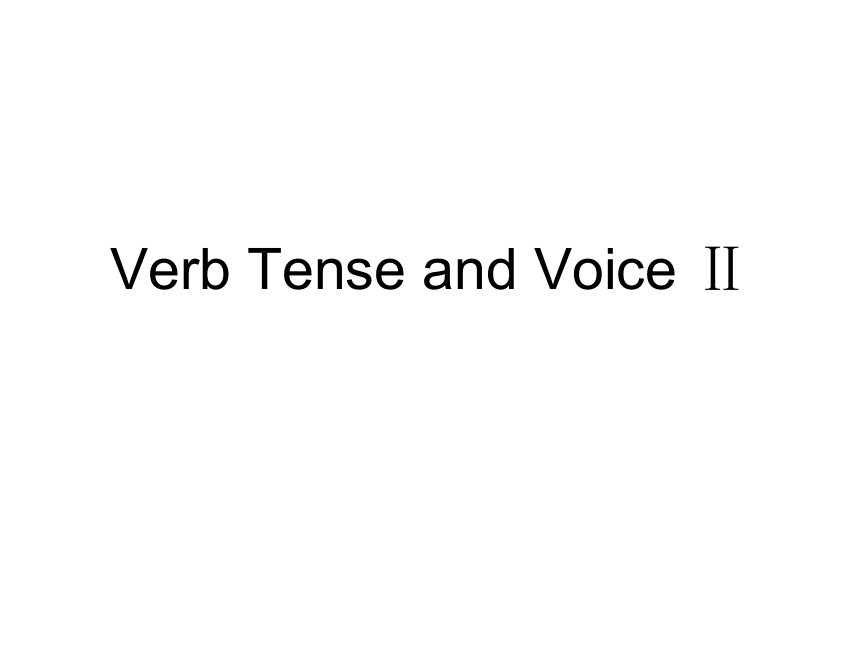 | |
| 格式 | zip | ||
| 文件大小 | 62.0KB | ||
| 资源类型 | 教案 | ||
| 版本资源 | 通用版 | ||
| 科目 | 英语 | ||
| 更新时间 | 2019-07-09 21:46:29 | ||
图片预览


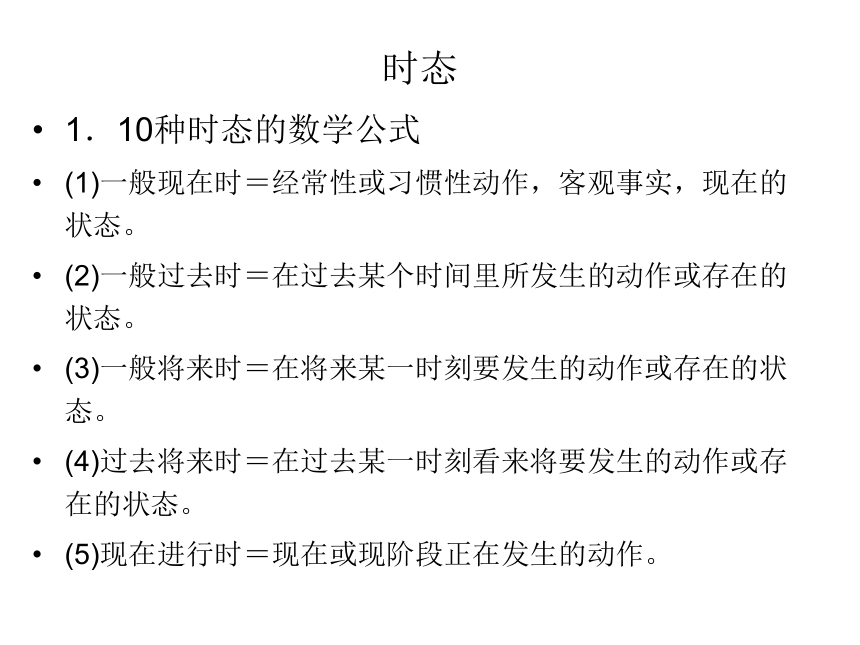
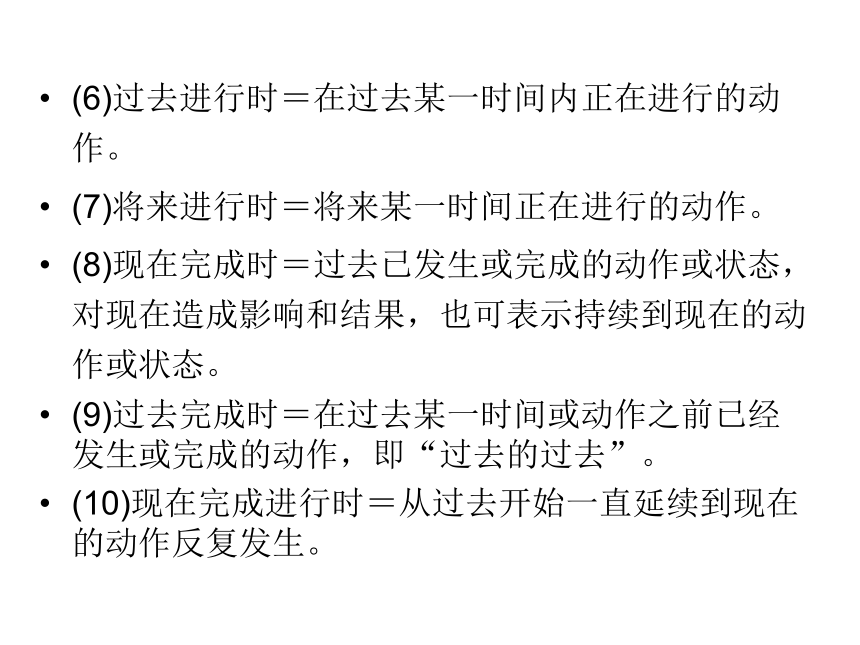

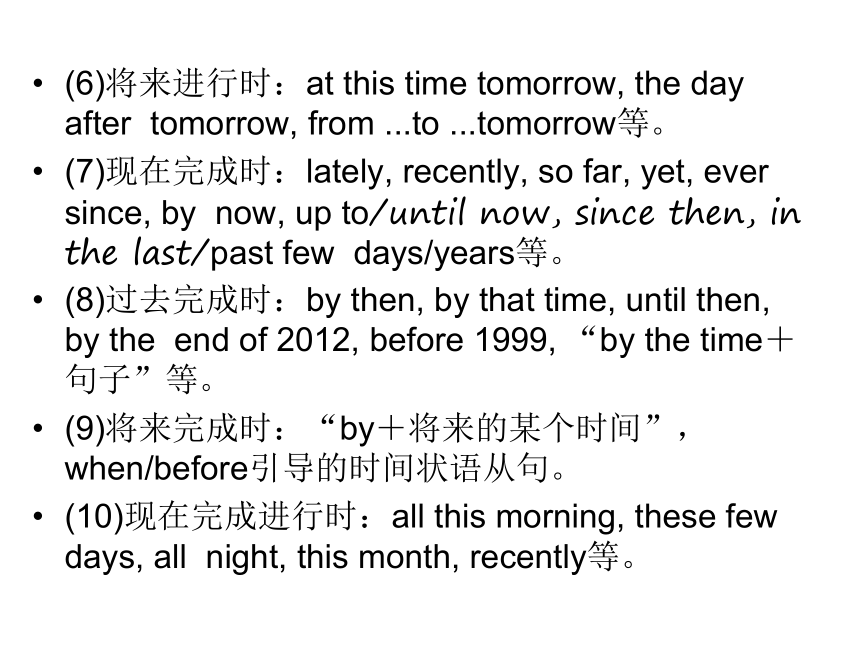
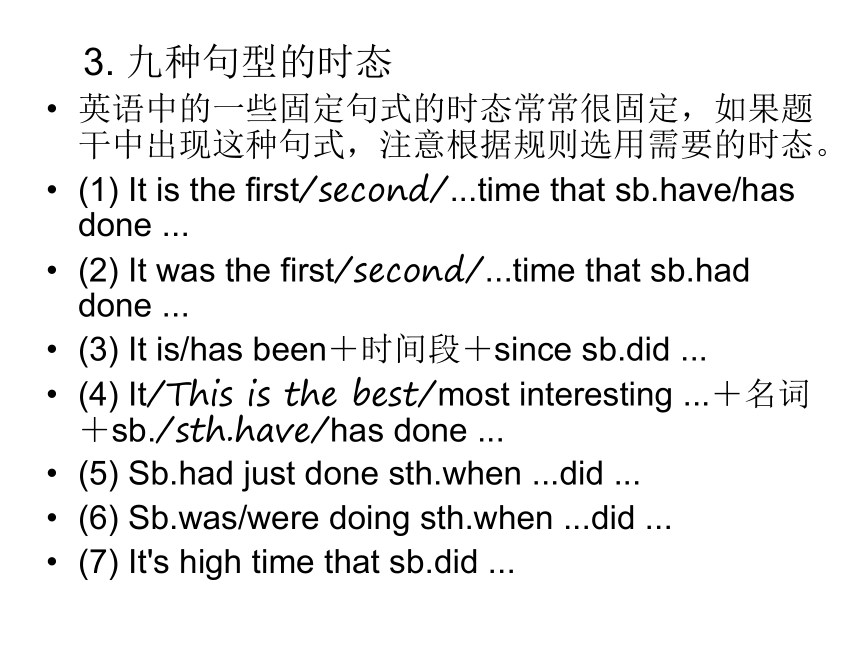
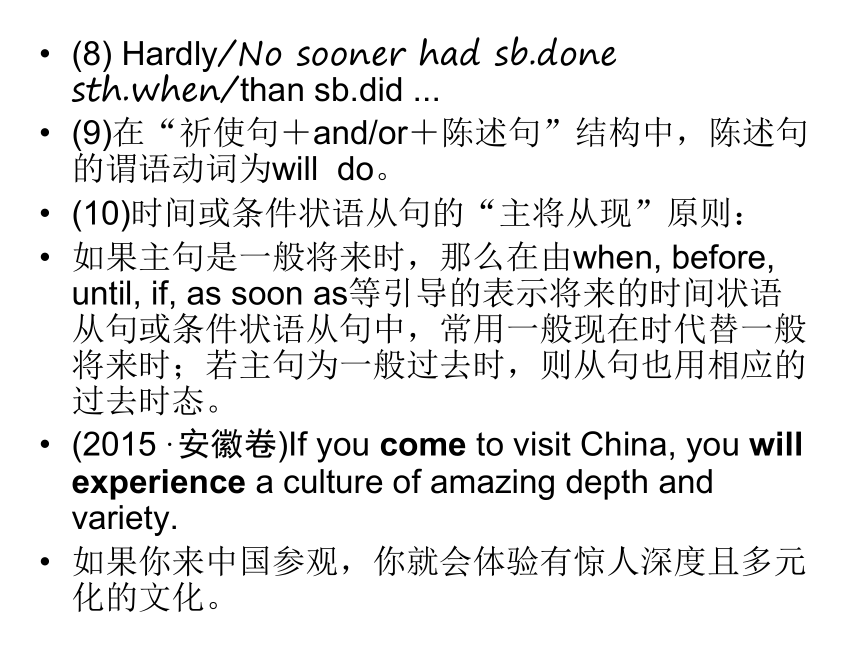

文档简介
课件22张PPT。Verb Tense and Voice Ⅱ时态和语态的区别时态:是英语谓语动词通过自身的变化来表示动作发生的时间和所处的状态的各种形式。
语态:表示主语和谓语之间的关系。
do does did
He does it.
It was done by him.
时态
1.10种时态的数学公式
(1)一般现在时=经常性或习惯性动作,客观事实,现在的状态。
(2)一般过去时=在过去某个时间里所发生的动作或存在的状态。
(3)一般将来时=在将来某一时刻要发生的动作或存在的状态。
(4)过去将来时=在过去某一时刻看来将要发生的动作或存在的状态。
(5)现在进行时=现在或现阶段正在发生的动作。(6)过去进行时=在过去某一时间内正在进行的动作。
(7)将来进行时=将来某一时间正在进行的动作。
(8)现在完成时=过去已发生或完成的动作或状态,对现在造成影响和结果,也可表示持续到现在的动作或状态。
(9)过去完成时=在过去某一时间或动作之前已经发生或完成的动作,即“过去的过去”。
(10)现在完成进行时=从过去开始一直延续到现在的动作反复发生。 2.题干中常出现的标志词或时间状语有:
(1)一般现在时:sometimes, now and then, often, every day/week, on Sundays等。
(2)一般过去时:yesterday, last week, three years ago, the other day(几天前), the day before yesterday, once upon a time, in 1990等。
(3)一般将来时:next week, tomorrow, in a week, in the future, later on, the day after tomorrow等。
(4)现在进行时:look, now, at present, at this moment, these days等。
(5)过去进行时:then, at that time, those days等。(6)将来进行时:at this time tomorrow, the day after tomorrow, from ...to ...tomorrow等。
(7)现在完成时:lately, recently, so far, yet, ever since, by now, up to/until now, since then, in the last/past few days/years等。
(8)过去完成时:by then, by that time, until then, by the end of 2012, before 1999, “by the time+句子”等。
(9)将来完成时:“by+将来的某个时间”, when/before引导的时间状语从句。
(10)现在完成进行时:all this morning, these few days, all night, this month, recently等。 3. 九种句型的时态
英语中的一些固定句式的时态常常很固定,如果题干中出现这种句式,注意根据规则选用需要的时态。
(1) It is the first/second/...time that sb.have/has done ...
(2) It was the first/second/...time that sb.had done ...
(3) It is/has been+时间段+since sb.did ...
(4) It/This is the best/most interesting ...+名词+sb./sth.have/has done ...
(5) Sb.had just done sth.when ...did ...
(6) Sb.was/were doing sth.when ...did ...
(7) It's high time that sb.did ...(8) Hardly/No sooner had sb.done sth.when/than sb.did ...
(9)在“祈使句+and/or+陈述句”结构中,陈述句的谓语动词为will do。
(10)时间或条件状语从句的“主将从现”原则:
如果主句是一般将来时,那么在由when, before, until, if, as soon as等引导的表示将来的时间状语从句或条件状语从句中,常用一般现在时代替一般将来时;若主句为一般过去时,则从句也用相应的过去时态。
(2015·安徽卷)If you come to visit China, you will experience a culture of amazing depth and variety.
如果你来中国参观,你就会体验有惊人深度且多元化的文化。 语态
1.被动语态的构成为“be+过去分词”,只要变换be的形式就可以得到不同时态的被动语态,除be外被动语态的构成形式还有:get/become+过去分词。
2.只有及物动词或相当于及物动词的短语才有被动语态,不及物动词或短语无被动语态。常考的不及物动词或短语:last, cost, spread, happen (to), take place, belong to, break out, go out, run out, work out。
3.主动形式表示被动含义
(1)表示感受、感官的系动词如feel, sound, taste, look等,后面跟形容词、名词构成系表结构,常常以主动形式表示被动意义。
(2)当sell, read, draw, wash, write, open, wear, run, burn等不及物动词后带状语(well/easily等)修饰,用来表示主语内在的品质或性能时用主动形式表示被动含义。①(安徽卷)While waiting for the opportunity to get promoted, Henry did his best to perform his duty.
在等待机会被提拔期间,亨利尽量履行好自己的职责。
②Food supplies in the flood-stricken area are running out. We must act immediately before there's none left.
洪水灾区的食品即将用完,我们必须在他们用完之前采取措施。
③— What about the books?
— Books of this kind sell well.
——这些书怎么样?
——这种书很畅销。时态和语态是语法填空和短文改错题的常考点,主要考查时态和语态在具体语境中的运用。解题时考生要先根据上下文或时间标志词判断时态,然后根据主语与谓语动词之间的逻辑关系来判断语态。 语法填空高考真题
1.(2015·新课标卷Ⅰ)It was raining lightly when I ________ (arrive) in Yangshuo just before dawn. But I didn't care.
解析:句意:当我在黄昏前到达阳朔时正下小雨。但是我不在意。由后句“But I didn't care.”可知这里应用一般过去时。
2.(2015·新课标卷Ⅱ)This cycle ________ (go) day after day: The walls warm up during the day and cool off during the night.
解析:句意:这个循环日复一日的进行……。主语this cycle为单数形式;句子以一般现在时为主;结合时间状语day after day可知应用goes。goes arrived 3.(2015·广东卷)While making great efforts to run away, she ________ (fall) over the hill and died.
解析:此空前为主语she,故该空填谓语,又根据and后的谓语died,可知该空填fell。
4.(2015·广东卷)He made cheese and butter for the family with what ________ (leave).
解析:谓语动词和主语之间为被动关系,应用被动语态,又因动作发生在过去,应用一般过去时,故填was left。
5.(2014·新课标卷Ⅱ)A boy on a bike _______(catch) my attention. He was riding beside the bus and waving his arms.
解析:所填词是句子的谓语,根据下句时态可知,catch my attention发生在过去,故填caught。caught fell was left 6.(2014·辽宁卷)Tai Chi ________ (call) “shadow boxing” in English.
解析:句意:太极在英文中被称为“shadow boxing”。所填词是句子的谓语,和句子的主语Tai Chi是被动关系,表示“……被称为”;句子说的是事实,应用一般现在时,故填is called。
7.(2014·广东卷)We ___________ (tell) that our rooms hadn't been reserved for that week.
解析:句意:我们被告知那一周房间没有预订。所填词是句子的谓语,和句子的主语we是被动关系,表示“我们被告知”;由从句时态判断出动作发生在过去,用一般过去时的被动语态,故填were told。 is called were told 技巧
第一步,确定句子是否缺少谓语
如果括号中给出的提示词是动词,首先要分析句子成分。如果句子缺少谓语,那么空格处应填谓语动词,就要考虑使用合适的时态和语态。
第二步,确定时态
要根据具体的语境、时间状语或另一动词的时态来判断用哪种时态。
第三步,确定语态
语态要根据主语和谓语动词的逻辑关系确定。主语和谓语动词之间是主动关系时动词就应用主动语态,是被动关系时就应用被动语态。
第四步,确定主谓一致
要注意谓语动词与主语在人称和数上保持一致。 短文改错高考真题
1.(2015·四川卷短文改错)As I tell you last time, I made three new friends here.答案与解析:tell→told 根据该句中的时间状语last time,可知动作发生在过去,应用一般过去时。2.(2015·浙江卷短文改错)It was full of students exercising. The view from the back of the classroom is also splendid.答案与解析:is→was 前一句谓语用的是过去时,故将is改为was。3.(2014·辽宁卷短文改错)This morning she starts barking even before 5 o'clock.答案与解析:starts→started 由时间状语this morning可知,此处“狗叫”是过去发生的事情,应用一般过去时。4.The arrows were looked like rain.答案与解析:去掉were或looked look like“看起来像……”为不及物动词短语,没有被动形式,故删去were,也可删掉looked,构成be like短语,意为“像……”。5.(2014·新课标卷Ⅰ短文改错)Since then—for all these years—we had been allowing tomatoes to self-seed where they please.答案与解析:had→have 句中时间状语是since then,谓语应用现在完成进行时,故将had改为have。6.Tea in China was traditionally drank from cups without handles.答案与解析:drank→drunk 根据句意及前面的was可知此处用被动语态,所以用过去分词。 诊断
1.时态错用
①通过上下文中“动作的先后关系”判断是否有一般现在时与一般过去时的错用。
②根据and判断前后动词时态是否一致。
③根据句中时间标志词如since then, last time等判断。
2.语态错用
①系动词和不及物动词(短语)没有被动语态,却误被用作被动语态。
②被动语态结构是否缺少be动词。
语态:表示主语和谓语之间的关系。
do does did
He does it.
It was done by him.
时态
1.10种时态的数学公式
(1)一般现在时=经常性或习惯性动作,客观事实,现在的状态。
(2)一般过去时=在过去某个时间里所发生的动作或存在的状态。
(3)一般将来时=在将来某一时刻要发生的动作或存在的状态。
(4)过去将来时=在过去某一时刻看来将要发生的动作或存在的状态。
(5)现在进行时=现在或现阶段正在发生的动作。(6)过去进行时=在过去某一时间内正在进行的动作。
(7)将来进行时=将来某一时间正在进行的动作。
(8)现在完成时=过去已发生或完成的动作或状态,对现在造成影响和结果,也可表示持续到现在的动作或状态。
(9)过去完成时=在过去某一时间或动作之前已经发生或完成的动作,即“过去的过去”。
(10)现在完成进行时=从过去开始一直延续到现在的动作反复发生。 2.题干中常出现的标志词或时间状语有:
(1)一般现在时:sometimes, now and then, often, every day/week, on Sundays等。
(2)一般过去时:yesterday, last week, three years ago, the other day(几天前), the day before yesterday, once upon a time, in 1990等。
(3)一般将来时:next week, tomorrow, in a week, in the future, later on, the day after tomorrow等。
(4)现在进行时:look, now, at present, at this moment, these days等。
(5)过去进行时:then, at that time, those days等。(6)将来进行时:at this time tomorrow, the day after tomorrow, from ...to ...tomorrow等。
(7)现在完成时:lately, recently, so far, yet, ever since, by now, up to/until now, since then, in the last/past few days/years等。
(8)过去完成时:by then, by that time, until then, by the end of 2012, before 1999, “by the time+句子”等。
(9)将来完成时:“by+将来的某个时间”, when/before引导的时间状语从句。
(10)现在完成进行时:all this morning, these few days, all night, this month, recently等。 3. 九种句型的时态
英语中的一些固定句式的时态常常很固定,如果题干中出现这种句式,注意根据规则选用需要的时态。
(1) It is the first/second/...time that sb.have/has done ...
(2) It was the first/second/...time that sb.had done ...
(3) It is/has been+时间段+since sb.did ...
(4) It/This is the best/most interesting ...+名词+sb./sth.have/has done ...
(5) Sb.had just done sth.when ...did ...
(6) Sb.was/were doing sth.when ...did ...
(7) It's high time that sb.did ...(8) Hardly/No sooner had sb.done sth.when/than sb.did ...
(9)在“祈使句+and/or+陈述句”结构中,陈述句的谓语动词为will do。
(10)时间或条件状语从句的“主将从现”原则:
如果主句是一般将来时,那么在由when, before, until, if, as soon as等引导的表示将来的时间状语从句或条件状语从句中,常用一般现在时代替一般将来时;若主句为一般过去时,则从句也用相应的过去时态。
(2015·安徽卷)If you come to visit China, you will experience a culture of amazing depth and variety.
如果你来中国参观,你就会体验有惊人深度且多元化的文化。 语态
1.被动语态的构成为“be+过去分词”,只要变换be的形式就可以得到不同时态的被动语态,除be外被动语态的构成形式还有:get/become+过去分词。
2.只有及物动词或相当于及物动词的短语才有被动语态,不及物动词或短语无被动语态。常考的不及物动词或短语:last, cost, spread, happen (to), take place, belong to, break out, go out, run out, work out。
3.主动形式表示被动含义
(1)表示感受、感官的系动词如feel, sound, taste, look等,后面跟形容词、名词构成系表结构,常常以主动形式表示被动意义。
(2)当sell, read, draw, wash, write, open, wear, run, burn等不及物动词后带状语(well/easily等)修饰,用来表示主语内在的品质或性能时用主动形式表示被动含义。①(安徽卷)While waiting for the opportunity to get promoted, Henry did his best to perform his duty.
在等待机会被提拔期间,亨利尽量履行好自己的职责。
②Food supplies in the flood-stricken area are running out. We must act immediately before there's none left.
洪水灾区的食品即将用完,我们必须在他们用完之前采取措施。
③— What about the books?
— Books of this kind sell well.
——这些书怎么样?
——这种书很畅销。时态和语态是语法填空和短文改错题的常考点,主要考查时态和语态在具体语境中的运用。解题时考生要先根据上下文或时间标志词判断时态,然后根据主语与谓语动词之间的逻辑关系来判断语态。 语法填空高考真题
1.(2015·新课标卷Ⅰ)It was raining lightly when I ________ (arrive) in Yangshuo just before dawn. But I didn't care.
解析:句意:当我在黄昏前到达阳朔时正下小雨。但是我不在意。由后句“But I didn't care.”可知这里应用一般过去时。
2.(2015·新课标卷Ⅱ)This cycle ________ (go) day after day: The walls warm up during the day and cool off during the night.
解析:句意:这个循环日复一日的进行……。主语this cycle为单数形式;句子以一般现在时为主;结合时间状语day after day可知应用goes。goes arrived 3.(2015·广东卷)While making great efforts to run away, she ________ (fall) over the hill and died.
解析:此空前为主语she,故该空填谓语,又根据and后的谓语died,可知该空填fell。
4.(2015·广东卷)He made cheese and butter for the family with what ________ (leave).
解析:谓语动词和主语之间为被动关系,应用被动语态,又因动作发生在过去,应用一般过去时,故填was left。
5.(2014·新课标卷Ⅱ)A boy on a bike _______(catch) my attention. He was riding beside the bus and waving his arms.
解析:所填词是句子的谓语,根据下句时态可知,catch my attention发生在过去,故填caught。caught fell was left 6.(2014·辽宁卷)Tai Chi ________ (call) “shadow boxing” in English.
解析:句意:太极在英文中被称为“shadow boxing”。所填词是句子的谓语,和句子的主语Tai Chi是被动关系,表示“……被称为”;句子说的是事实,应用一般现在时,故填is called。
7.(2014·广东卷)We ___________ (tell) that our rooms hadn't been reserved for that week.
解析:句意:我们被告知那一周房间没有预订。所填词是句子的谓语,和句子的主语we是被动关系,表示“我们被告知”;由从句时态判断出动作发生在过去,用一般过去时的被动语态,故填were told。 is called were told 技巧
第一步,确定句子是否缺少谓语
如果括号中给出的提示词是动词,首先要分析句子成分。如果句子缺少谓语,那么空格处应填谓语动词,就要考虑使用合适的时态和语态。
第二步,确定时态
要根据具体的语境、时间状语或另一动词的时态来判断用哪种时态。
第三步,确定语态
语态要根据主语和谓语动词的逻辑关系确定。主语和谓语动词之间是主动关系时动词就应用主动语态,是被动关系时就应用被动语态。
第四步,确定主谓一致
要注意谓语动词与主语在人称和数上保持一致。 短文改错高考真题
1.(2015·四川卷短文改错)As I tell you last time, I made three new friends here.答案与解析:tell→told 根据该句中的时间状语last time,可知动作发生在过去,应用一般过去时。2.(2015·浙江卷短文改错)It was full of students exercising. The view from the back of the classroom is also splendid.答案与解析:is→was 前一句谓语用的是过去时,故将is改为was。3.(2014·辽宁卷短文改错)This morning she starts barking even before 5 o'clock.答案与解析:starts→started 由时间状语this morning可知,此处“狗叫”是过去发生的事情,应用一般过去时。4.The arrows were looked like rain.答案与解析:去掉were或looked look like“看起来像……”为不及物动词短语,没有被动形式,故删去were,也可删掉looked,构成be like短语,意为“像……”。5.(2014·新课标卷Ⅰ短文改错)Since then—for all these years—we had been allowing tomatoes to self-seed where they please.答案与解析:had→have 句中时间状语是since then,谓语应用现在完成进行时,故将had改为have。6.Tea in China was traditionally drank from cups without handles.答案与解析:drank→drunk 根据句意及前面的was可知此处用被动语态,所以用过去分词。 诊断
1.时态错用
①通过上下文中“动作的先后关系”判断是否有一般现在时与一般过去时的错用。
②根据and判断前后动词时态是否一致。
③根据句中时间标志词如since then, last time等判断。
2.语态错用
①系动词和不及物动词(短语)没有被动语态,却误被用作被动语态。
②被动语态结构是否缺少be动词。
